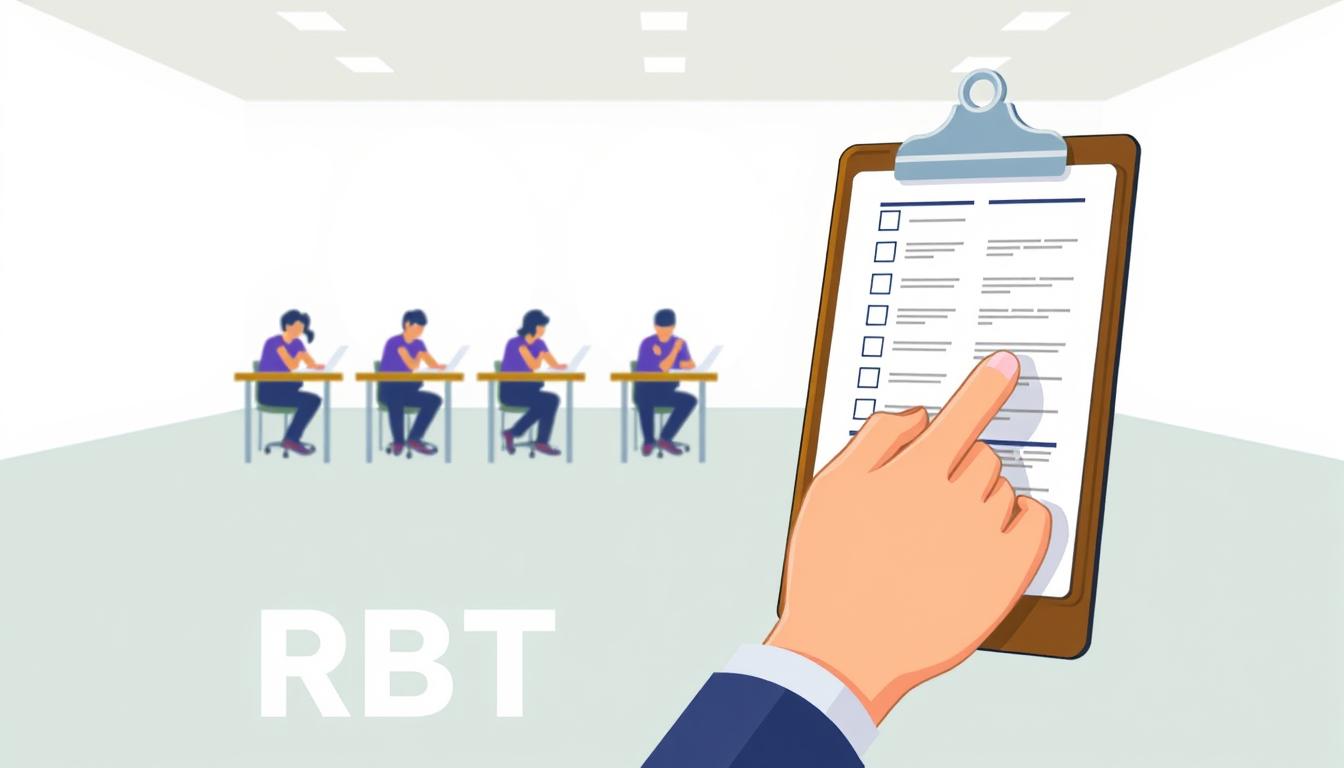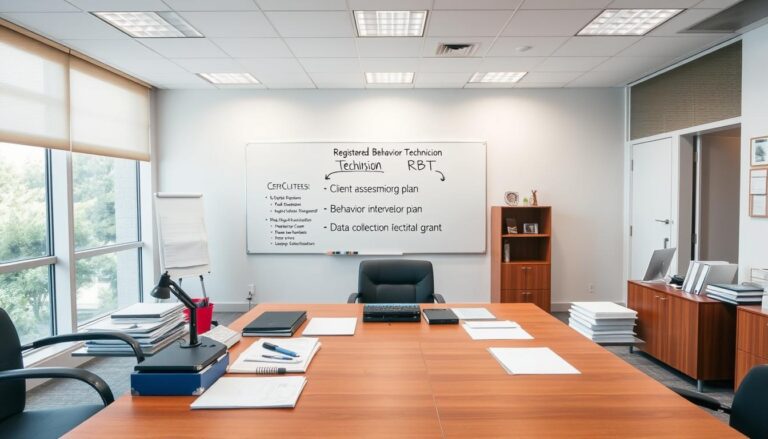RBT Exam Breakdown: Questions Count Revealed
The RBT exam is a big step for those wanting to become a Registered Behavior Technician. It’s given by the Behavior Analyst Certification Board (BACB). This test checks if you have the skills and knowledge needed for behavior analysis.
Knowing a lot about ABA techniques, how to document, and ethics in behavior management is important. Getting ready well is key to pass this exam.
The RBT certification process is very detailed. It makes sure everyone meets the same high standards. Learning about the RBT exam can really help you. It prepares you for the questions you’ll see.
Overview of the RBT Exam
The RBT exam is key for those wanting to be Registered Behavior Technicians. It’s important to know what the exam is about, why it matters, and what you need to do to pass.
Purpose and Importance
The RBT test is very important. It checks if someone is ready to work with people who need help with their behavior. It makes sure they know how to do their job well and safely.
Eligibility Requirements
To become a Registered Behavior Technician, you must meet certain requirements. First, you need to finish a 40-hour training course. Then, you must pass a test given by a certified expert. This test makes sure you can use what you learned in real situations.
Exam Administrator
The Behavior Analyst Certification Board (BACB) runs the exam. They make sure the test is fair and follows strict rules. This means the exam is reliable and trustworthy, helping to ensure that only qualified people get certified.
Exam Structure and Format
Knowing the RBT exam layout is key for those aiming to be Registered Behavior Technicians. The test is a 90-minute multiple-choice exam with 75 questions. It checks your knowledge and skills in various areas.
Question Types
The RBT exam tests your practical skills and behavioral principles. You’ll face scenario-based questions that ask for the best response to real-life situations. This way, it checks if you can use your knowledge in practical ways.
Time Allotted
The time you have to complete the RBT exam is 90 minutes for 75 questions. Managing your time well is essential. Each question is designed to test your quick thinking and application of principles under time pressure. Good preparation helps you use your time wisely to answer all questions.
| Aspect | Details |
|---|---|
| Total Questions | 75 |
| Time Allotted | 90 minutes |
| Question Format | Multiple-choice |
| Key Areas Covered | Assessment, Behavior Reduction, Professional Conduct |
To know the RBT exam layout, the types of questions, and how to manage your time can boost your success. For more help, check out our RBT practice exams. They’re designed to simulate the real test and help you prepare better.
How many questions are on the RBT exam
Knowing the layout of the Registered Behavior Technician exam is key for those aiming to become RBTs. Many candidates ask, “How many questions are on the RBT exam?” This info helps them plan their study time and feel more ready for the exam.
Number of Questions
The RBT exam has 85 questions in total. People often ask how these questions are split. Out of 85, 75 are for scoring, and the other 10 are pilot questions. These pilot questions are not scored but help test future exam content.
Even though they don’t count towards your score, treat all questions seriously. It’s hard to tell which ones are pilot questions during the test.
Scored vs. Unscored Questions
The exam questions are designed to check your skills in different areas. Here’s a look at scored and unscored questions:
| Type of Questions | Count |
|---|---|
| Scored Questions | 75 |
| Unscored (Pilot) Questions | 10 |
| Total Questions | 85 |
Every question on the RBT exam is a chance to show your knowledge and abilities. By knowing the number of questions and the difference between scored and unscored ones, you can prepare better. This helps you feel more confident and clear-headed during the exam.
Content Areas of the RBT Exam
The RBT exam covers key areas important for a Registered Behavior Technician’s job. Knowing these areas helps you practice well and pass the exam.
Measurement
Measurement is a big part of the RBT exam. It deals with collecting data to track progress and see if interventions work. Being good at collecting data helps measure RBT skills and assess behavior technicians.
Assessment
In the assessment section, you’ll learn about supporting behavioral assessments. This includes skill and functional behavior assessments. It’s key for accurate assessments and making good intervention plans.
Skill Acquisition
The skill acquisition section is about teaching new skills. It covers how to implement plans and use strategies for different needs.
Behavior Reduction
Behavior reduction focuses on managing and reducing bad behaviors. It teaches you to understand why behaviors happen and how to use interventions to lessen them.
Documentation and Reporting
Keeping accurate records is vital for RBTs. This part of the exam makes sure you can document progress well. It’s important for tracking and showing transparency in treatment.
Professional Conduct and Scope of Practice
The last section is about being professional and knowing your limits. It talks about ethics, boundaries, and following field guidelines and standards.
| Content Area | Description |
|---|---|
| Measurement | Data collection techniques essential for RBT skills measurement and behavior technician assessments. |
| Assessment | Supporting behavioral assessments including skill and functional behavior assessments. |
| Skill Acquisition | Implementation of intervention plans to teach new skills. |
| Behavior Reduction | Strategies for managing and reducing problematic behaviors. |
| Documentation and Reporting | Maintaining accurate and detailed records. |
| Professional Conduct and Scope of Practice | Adherence to ethical responsibilities and professional boundaries. |
Preparation Tips for the RBT Exam
To prepare well for the RBT exam, you need a good study plan. It’s important to use detailed study materials and practice with real exam-like tests. These steps are key to doing well.
Study Guides and Materials
Begin with the RBT Task List. It shows what you need to know for the exam. Then, read textbooks and guides from the Behavior Analyst Certification Board (BACB). These materials help you learn everything you need to know.
Practice Tests
Practice tests are very important. They make you feel like you’re taking the real exam. They also show you where you need to improve. By practicing a lot, you’ll feel more confident and understand the exam better.
| Resource | Purpose |
|---|---|
| RBT Task List | Guides study focus and ensures coverage of all content areas |
| Textbooks | Provides detailed explanations and real-life examples |
| Practice Tests | Simulates exam environment and highlights weak areas |
Taking the RBT Exam: What to Expect
On the RBT exam day, candidates need to arrive prepared with the correct identification. Knowing the behavior technician exam process can help smooth the way. The testing environment is strict, so you won’t have personal items or study material during the test.
Knowing what to expect RBT test-wise can reduce anxiety. The exam includes various question types that cover multiple areas of focus. These can make your experience more manageable.
Staying informed about the layout and format of the RBT exam day can help you feel more comfortable. Remember, preparation is not just about studying. It also includes knowing the behavior technician exam process. Follow these guidelines to ensure your exam day runs smoothly and maximize your chances of success.
Scoring and Passing Criteria
RBT exam scoring is key to seeing if you’re a Registered Behavior Technician (RBT). The exam scores are adjusted to make sure everyone is judged fairly. This is because different versions of the exam have different levels of difficulty.
Passing Scores
To pass the RBT exam, you need to score high enough. The exact score needed might change, but it’s very important. Scoring well shows you’re good at everything the exam tests.
Scaled Scoring
Getting to know how RBT results work helps you study better. Scaled scoring makes sure everyone is judged the same way. It means no one gets an unfair advantage or disadvantage.
Common Challenges and How to Overcome Them
Starting your journey to become a Registered Behavior Technician (RBT) comes with its own set of obstacles. It’s important to know these challenges and how to tackle them. This knowledge is key to your success.
Time Management
Time management is a big challenge for many during the RBT test. Taking mock exams under real-time conditions helps you learn to pace yourself. Here are some tips to manage your time better:
- Set time limits for each section in practice tests.
- Answer questions you know quickly first.
- Keep track of your progress and adjust your pace as needed.
Handling Difficult Questions
Dealing with tough questions can add stress to the RBT exam. To improve, it’s essential to develop strategies for these questions:
- Read each question carefully and identify key terms.
- Use the process of elimination to narrow down your choices.
- Stay calm and avoid spending too much time on any single question.
By addressing these challenges with structured strategies, you’ll boost your confidence and efficiency. This will help you score higher on the exam.
Post-Exam Steps
After finishing the RBT exam, knowing what comes next is key. The journey doesn’t stop at the testing center. It’s important to understand the steps that follow to get ready for what’s next.
Receiving Your Results
Waiting for your RBT exam results is exciting. The process is simple. Your score is checked, and you get your results quickly. Looking at your scores in different areas can show you what you’re good at and what you need to work on.
Retake Policies
If you don’t pass the first time, don’t worry. Knowing the RBT exam retake policy helps a lot. The Board Certified Behavior Analyst (BCBA) has rules for retaking the exam. You have to wait a certain time before trying again. This time lets you study more, fill in knowledge gaps, and get ready better for your next try.
| Action | Details |
|---|---|
| Result Notification | Receive your detailed score report soon after the RBT exam. |
| Review of Scores | Analyze your performance across various content areas. |
| Retake Policy | Understand and comply with the retake waiting period and policies. |
Resources for Additional Support
Getting ready for the RBT exam can be tough. But, there are many resources to help with RBT exam help and RBT study support. Using these can make you understand and feel ready for the exam.
Official BACB resources give you all you need to know for the exam. They have study guides, practice exams, and detailed explanations. These materials make sure you know the exam’s structure and content well.
Online forums and study groups are also great for additional RBT resources. They offer tips and support from others who have taken the exam. Being part of these groups can clear up any questions and help you remember important points.
Here’s a quick comparison of available resources:
| Resource Type | Details |
|---|---|
| Official BACB Resources | Guidelines, practice exams, content breakdown |
| Online Forums | Peer support, study tips, experience sharing |
| Supplementary Materials | Additional readings, flashcards, video tutorials |
Using a mix of these resources can give you the best RBT exam help. Whether you need RBT study support or additional RBT resources, these options will help you pass the exam.
Importance of RBT Certification
Getting your RBT certification brings many benefits to your career. It opens doors to work in different places, like schools and clinics. It shows you’re serious about high standards in behavior analysis, making you more credible.
Career Opportunities
With RBT certification, you can explore many career paths. You can work in schools, clinics, or private practices. Certified RBTs are valued for their training and ethics. This leads to job opportunities and chances for growth in behavior analysis.
Long-Term Benefits
The long-term perks of RBT certification are big. RBT jobs are stable and in demand. This certification also helps you grow personally and professionally. You can help people and families with behavioral issues.
| Benefit | Description |
|---|---|
| Professional Credibility | Enhanced standing in the field of behavior analysis. |
| Career Stability | Long-term job security and opportunities for advancement. |
| Impactful Work | Making a significant difference in individuals’ lives. |
Conclusion
Getting certified as a Registered Behavior Technician (RBT) is both tough and rewarding. We’ve covered the key parts like the exam’s structure, what it covers, and how to prepare. Knowing these helps you move through the certification process smoothly, boosting your confidence.
We’ve talked about everything from who can take the exam to the need for professional behavior. Using practice tests, study guides, and good time management can help you do well. The tips and tools we’ve shared aim to support you fully as you prepare.
Getting RBT certified can lead to great career chances in behavior analysis. RBTs play a key role in providing ethical ABA services, helping clients a lot. We hope you’re ready to tackle the exam with confidence. For more practice, check out our RBT mock exams.
FAQs
How many questions are on the RBT exam?
The RBT exam has 85 questions. Out of these, 75 are scored. The other 10 are unscored pilot questions.
What is the format of the RBT exam?
The RBT exam is a multiple-choice test. It covers topics like assessment, behavior reduction, and professional conduct.
How long do candidates have to complete the RBT exam?
Candidates have 90 minutes to finish the RBT exam.
What are the primary content areas covered in the RBT exam?
The exam focuses on Measurement, Assessment, Skill Acquisition, and Behavior Reduction. It also covers Documentation and Reporting, and Professional Conduct and Scope of Practice.
What are the eligibility requirements for taking the RBT exam?
To take the RBT exam, candidates must complete a 40-hour training course. They also need to pass a competency assessment by a certified professional.
How is the RBT exam scored?
The RBT exam uses a scaled scoring system. Candidates must meet or exceed a certain threshold to pass.
What should candidates expect on the day of the RBT exam?
Candidates should bring the right ID and know the exam procedure. Personal items and study materials are not allowed once the exam starts.
What resources can help candidates prepare for the RBT exam?
Candidates can use study guides, the RBT Task List, textbooks, and practice tests. These resources help prepare for the exam.
What if a candidate doesn’t pass the RBT exam?
If a candidate doesn’t pass, they can retake the exam after a certain time. It’s important to review and improve on weak areas.
What are the career opportunities for certified RBTs?
RBT certification opens doors to many career opportunities. Certified RBTs work in educational and clinical settings, helping individuals with behavioral needs.
What are the long-term benefits of becoming a certified RBT?
Being a certified RBT offers career stability and growth. It also brings fulfillment from helping individuals and families with behavioral challenges.
How important is time management during the RBT exam?
Time management is key, as candidates have 90 minutes for 85 questions. Timed practice tests can improve skills.
How can candidates handle difficult questions on the RBT exam?
Candidates should think critically and use elimination to tackle tough questions. Practice tests help develop these strategies.
Who administers the RBT exam?
The Behavior Analyst Certification Board (BACB) manages and administers the RBT exam.
What is the purpose of the pilot questions on the RBT exam?
The 10 unscored pilot questions test future exam content. They do not affect the final score.




